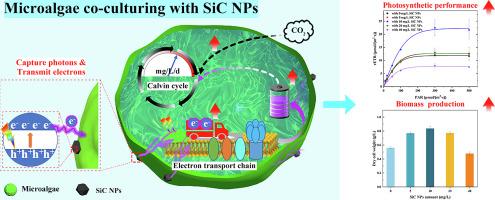SiC nanoparticles promote CO2 fixation and biomass production of Chlorella sorokiniana via expanding the abilities of capturing and transmitting photons
IF 4.5
2区 生物学
Q1 BIOTECHNOLOGY & APPLIED MICROBIOLOGY
Algal Research-Biomass Biofuels and Bioproducts
Pub Date : 2024-12-01
DOI:10.1016/j.algal.2024.103814
引用次数: 0
Abstract
Microalga-semiconductor hybrids for solar-to-biomass conversion which integrate microalgal photosynthesis with the efficient light capture of artificial semiconductors can significantly promote CO2 fixation and productivity of microalgal cells. However, such pertinent studies are poor and the promoting mechanism is unclear yet. Silicon carbide nanoparticles (SiC NPs) have remarkable biocompatibility and photocatalytic ability. Here, to get insights into the promoting mechanism the hybrids were constructed by using SiC NPs and microalga Chlorella sorokiniana, and tested the cell growth, chlorophyll fluorescence, changes in extracellular morphology and structure, absorption spectroscopy and photo-electrochemistry. The results showed that in the hybrid systems with SiC NPs in 0-20 mg/L the cell growth, CO2 fixating and biomass accumulation rate were promoted significantly, with 90 %, 49 % and 38 % increase in the maximum relative electron transport rates, maximal biomass and lipid yields, respectively, in the hybrid with 10 mg/L SiC NPs added. It suggested that SiC NPs can promote microalgal photosynthesis by transferring photogenerated electrons into the electron transport chain, expanding the capture of photoenergy and enhancing intracellular electron transport, rather than photoluminescence or photocatalytic CO2 reduction products.

碳化硅纳米颗粒通过扩展捕获和传输光子的能力来促进小球藻的二氧化碳固定和生物量生产
将微藻光合作用与人工半导体的高效光捕获相结合的用于太阳能-生物质转化的微藻-半导体杂交体可以显著促进微藻细胞的二氧化碳固定和生产力。然而,相关研究较少,促进机制尚不清楚。碳化硅纳米颗粒(SiC NPs)具有良好的生物相容性和光催化能力。本研究以碳化硅NPs与小球藻构建杂交体,并对其生长、叶绿素荧光、胞外形态结构、吸收光谱和光电化学变化进行了检测。结果表明,在0 ~ 20 mg/L SiC NPs的杂交体系中,细胞生长、CO2固定和生物量积累速率显著提高,添加10 mg/L SiC NPs的杂交体系中,最大相对电子传递速率、最大生物量和最大脂质产量分别提高了90%、49%和38%。这表明,SiC NPs通过将光生电子转移到电子传递链中,扩大光能的捕获并增强细胞内电子传递来促进微藻的光合作用,而不是光致发光或光催化CO2还原产物。
本文章由计算机程序翻译,如有差异,请以英文原文为准。
求助全文
约1分钟内获得全文
求助全文
来源期刊

Algal Research-Biomass Biofuels and Bioproducts
BIOTECHNOLOGY & APPLIED MICROBIOLOGY-
CiteScore
9.40
自引率
7.80%
发文量
332
期刊介绍:
Algal Research is an international phycology journal covering all areas of emerging technologies in algae biology, biomass production, cultivation, harvesting, extraction, bioproducts, biorefinery, engineering, and econometrics. Algae is defined to include cyanobacteria, microalgae, and protists and symbionts of interest in biotechnology. The journal publishes original research and reviews for the following scope: algal biology, including but not exclusive to: phylogeny, biodiversity, molecular traits, metabolic regulation, and genetic engineering, algal cultivation, e.g. phototrophic systems, heterotrophic systems, and mixotrophic systems, algal harvesting and extraction systems, biotechnology to convert algal biomass and components into biofuels and bioproducts, e.g., nutraceuticals, pharmaceuticals, animal feed, plastics, etc. algal products and their economic assessment
 求助内容:
求助内容: 应助结果提醒方式:
应助结果提醒方式:


